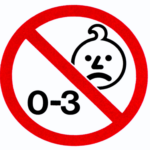
Safe non-food consumer Products in the EU and China
Disguise costumes are considered to be toys when designed or intended, whether or not exclusively, for use in play by children under 14 years of age. Disguise costumes may include carnival costumes, fancy dress and outfits used in play to represent a character, such as a policeman or woman, cowboy, princess or cartoon character.
If the disguise costume contains any electrical components, it must also comply with the requirements for Electric Toys in addition to the below requirements.
The most common risks identified in this product sector are set out below.
1. Mechanical/physical risks:
2. Chemical risks:
3. Thermal risks:
Electrical risks
Optical risks
Risks from batteries
This is a list of examples of common risks. However, the manufacturer has to carry out an assessment of the toy that covers all relevant risks that may be associated with the product and actions taken to mitigate these risks where possible. A general definition of risk and its relationship to hazards can be found in the factsheet on Risk management.
Specific examples of measures taken against dangerous disguise costumes offered for sale in the European Union are available on the Safety Gate website. Type ‘disguise costumes’ into the free text search box (but without the quotation marks) and select the ‘Toys’ Product Category to view notified examples. A better understanding of mistakes made in the safety assessment of the toy or its manufacture can help avoid their repetition.
These products are governed mainly by the Toy Safety Directive (2009/48/EC) (also available in Chinese). The Directive lays down the safety criteria that all toys must meet before they can be marketed in the EU. Toys must comply with the essential safety requirements set out in this Directive. Guidance and more specific details can be found on the European Commission’s website and in the following documents:
Please also check the factsheet for Power Supplies, Chargers and Adaptors for safety requirements for the external power supply (if applicable).
NB: For toys, certificates are only recommended, as well as involving a third-party laboratory in the conformity assessment excluding exceptional cases (if the manufacturer doesn’t follow the harmonised standards).
“Harmonised standards” exist in the EU for toys. A toy complying with these standards is presumed to be in conformity with the essential safety requirements set out in the Toy Safety Directive if the standards are referenced in the Official Journal of the European Union (OJEU). Further information on, and the list of harmonised standards for toys is available from here.
Note: The site of CEN (the European standardisation organisation) provides links to the national standardisation bodies’ websites. In addition, the China Standards Information Services Network can be used to access European standards.
The following standard applies to toys:
EN71 Toys
The standard has been published in 14 parts. The most relevant parts for disguise costumes are:
However, the standard series covers other safety issues and manufacturers are strongly advised to consult all parts. It is important to note that the latest edition of the standard referenced in the OJEU (including any amendments) should be applied.
Standard EN IEC 62115:2020 with the amendment EN IEC 62115:2020/A11:2020 applies to electric toys, i.e. toys having at least one function dependant on electricity. The standard covers the safety of electric toys in relation to their electrical function. It reduces risks when playing with electric toys, especially those risks that are not evident to users. Key parts of the standard are:
However, the standard series covers other safety issues and manufacturers are strongly advised to consult all parts. It is important to note that the latest edition of the standard referenced in the OJEU (including any amendments) should be applied.
In addition, if the toy can communicate wirelessly, (e.g. incorporates Bluetooth or Wi-Fi used for remote control), it should meet the requirements of the Radio Equipment Directive (2014/53/EU).
Small parts in toys
Toys intended for use by children under 36 months and toys intended to be put in the mouth (regardless of the age of the child) as well as their component parts and any of their detachable parts must be of such dimensions as to prevent their being swallowed or inhaled.
If the toy (or separate part) fits completely into the small parts cylinder – defined in standard EN 71-1: Mechanical and physical properties – it will be defined as a small part and will therefore fail to meet this requirement of the Toy Safety Directive.
Specific limits for chemicals
Toys intended for children under 36 months and toys intended to be placed in the mouth (regardless of the age of the child) need to respect stricter limit values for certain chemicals, as listed in Appendix C to Annex II to the Toy Safety Directive. In addition, specific migration limits for nitrosamines and nitrosatable substances are set out for these two categories of toys in Annex II Part 3 Point 8 of the Directive.
Hygiene
Toys intended for use by children under 36 months must be designed and manufactured in such a way that they can be cleaned. Textile toys should be washable, except if they contain mechanisms that may be damaged if soak washed (in which case there should be a possibility for a surface cleaning). The toy shall fulfil the safety requirements also after having been cleaned.
While manufacturer’s need to familiarise themselves with all the laws which apply to their specific products, the following summarises some further key applicable laws:
The following are obligatory:

Warnings and instructions for use need to draw attention of users and supervisors to the inherent hazards and associated risks and how to avoid injury.
Safety warnings are obligatory for many types of toys including disguise costumes. For example, toys not suitable for children under 3 years old must include a warning stating “Not suitable for children under 36 months” or “Not suitable for children under three years” or a warning in the form of the graphic below. The warning shall be accompanied by a brief indication, which may appear in the instructions for use, of the specific hazard calling for this precaution.

Attention! This warning should be used only in circumstances where the toy is genuinely NOT intended for children under 3 years old and does not exempt manufacturers from complying with specific additional requirements imposed on these types of toys.
To ensure safety of disguise costumes there is also a range of general requirements to be fulfilled. These are explained in the following factsheets and need to be read in conjunction with this factsheet:
You may also visit the SPEAC ACADEMY to learn more about the EU Safety requirements.
The provided information was updated in 2025. Please note that some of the provided information could change during possible subsequent revisions of legislation, standards, and guidance documents. For any updates of official information on the EU product safety rules, please follow the Link to the webpage of the European Commission.
This document was produced with the financial support of the European Union. Its contents are the sole responsibility of SPEAC project and do not necessarily reflect the views of the European Union.